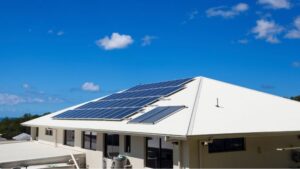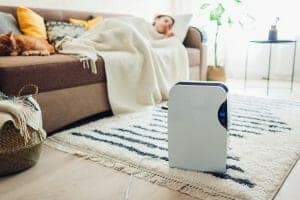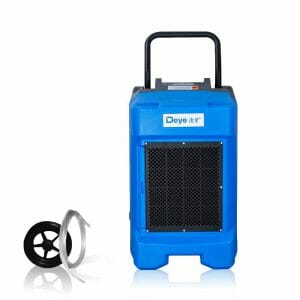
As temperatures rise due to climate change, air conditioners are becoming essential appliances for many homeowners to stay cool in the summer months. However, running an air conditioner can significantly increase electricity bills. Solar power provides a renewable and increasingly affordable alternative energy source. Determining the optimal number of solar panels needed to power an air conditioner depends on factors like the AC unit’s energy efficiency, solar panel output, and household electricity usage.
This article will provide you with an overall opinion on your solar panels and how to calculate how many solar panels are needed to run your air conditioner.
The Overview of Run an AC Unit With Solar Power
When you look at pairing your air conditioning unit with solar panels, the key is to align the energy production of the panels with the power consumption of your AC. It’s all about the watts; this is the unit of power that’s fundamental in measuring both the output of solar panels and the energy demands of your air conditioner.
Your air conditioner’s cooling capacity, which is often expressed in tons or BTUs, translates to its wattage demand.
- Central Air Conditioning
Central air conditioning systems tend to have the highest power consumption, averaging between 3,000-5,000 watts per hour. To efficiently run a central AC unit will require installing at least 3 kilowatts (kW) of solar panel output. Since most residential solar panels generate around 100 watts, 30 panels would be needed to generate this 3 kW of power. To fully offset the AC’s electricity usage would require even more solar – around 30 panels or 3 kW of capacity.
- Large Window Unit
Large window AC units consume 1,800-2,500 watts hourly on average. To power one of these units would require a minimum 2 kW solar installation. Since each 100W panel provides 0.1 kW, 20 panels or 2 kW of solar generation would allow the unit to operate during peak cooling hours. Fully powering the home would require additional solar capacity.
- Medium Window Unit
Medium window units have power demands in the 1,000-1,800 watt range per hour. To effectively run one of these AC sizes would mean installing at least 1 kW or 10 panels of 100W capacity each. This solar array could meet much of the cooling needs on sunny afternoons.
- Small Window Unit
The smallest window air conditioners only use 500-1,000 watts hourly. A half kW or 5 panels could power one of these compact units during periods of high sun. For whole-home offset, more solar may be needed.
Solar Panel Output
- Light-Use AC (500 W): 2-3 solar panels
- Medium Room AC (1,000-1,500 W): 4-6 solar panels
- Heavy-Use Central AC (3,000 W): 10-12 solar panels
Note: The number of panels assumes each panel produces around 300 watts under ideal conditions.
Here is a table:
| AC Unit Size | BTU Range | Average Power Draw (Watts) |
|---|---|---|
| Small Window Unit | 5,000 BTU or less | 500 |
| Medium Window Unit | 5,000 – 10,000 BTU | 900 |
| Large Window Unit | 10,000 – 15,000 BTU | 1,400 |
| Extra Large Window Unit | 15,000 – 25,000 BTU | 1,800 |
| Central Air System | 15,000 – 60,000 BTU | 3,000 – 5,000 |
Determining Solar Panel Needs

Every air conditioner uses a different amount of power. To effectively harness solar energy for your air conditioning, you’ll need to conduct some precise calculations. Here, we’ll cover how to assess your AC’s power demands and find the right amount of solar power to meet those needs.
Calculating AC Power Requirements
Your air conditioner comes with specific power needs, typically rated in watts (W) or kilowatts (kW). Check the manufacturer’s specifications for exact figures. A central aspect to consider is the unit’s tonnage, which relates to the cooling capacity. One ton of cooling is roughly equivalent to 12,000 BTU (British Thermal Units) per hour.
- 1-ton AC unit: Approx 3,500W – 4,000W during operation
- Surge current: Momentarily higher wattage during compressor startup
Calculate the energy consumption in watt-hours (Wh), considering the hours you run the AC. Here’s a basic formula:
Hours of operation x Watts (W) = Watt-hours (Wh)
Italicize the brand or specific model of your air conditioner for accurate wattage figures, if known, i.e., Brand Model XYZ.
Assessing Solar Panel Output
The output of a solar panel is typically rated in watts peak (Wp), which indicates the panel’s maximum potential output under ideal testing conditions. However, the actual energy produced in real-world installations is usually lower due to various environmental and situational factors.
- Sunlight Hours: The number of hours of direct sunlight a panel receives each day greatly impacts output. Areas with fewer cloudy days and more daylight hours will see higher annual energy yields. Panels in partly shaded locations or mounted at suboptimal angles produce less power.
- Shading: Even partial shading of a single solar module can significantly reduce overall panel output. Trees, buildings or other obstructions that cast shadows on the panels at any time of day lower efficiency. It’s best to mount panels in an open, unshaded area.
- Panel Angle: The angle at which solar panels are mounted in relation to the sun also influences performance. Panels oriented directly south (in the northern hemisphere) and tilted at an angle close to the location’s latitude perform best. Steeper or more shallow angles result in less exposure to the sun’s rays.
- Temperature: Higher ambient temperatures can slightly decrease a panel’s performance. Cooler panels operate at maximum rated efficiency, while very hot panels may underperform by 10-15% compared to their Wp rating. Proper ventilation helps regulate temperatures.
- Dirt & Wear: Over time, dust, pollen, bird droppings and other debris accumulating on panels reduces sunlight transmission. Regular cleaning helps maintain close to the rated wattage. Older panels also gradually lose efficiency through material degradation.
You’ll calculate the expected power output in watt-hours (Wh) with the formula:
Solar Panel Rating (W) x Peak Sunshine Hours = Daily Watt-hours (Wh)
This will give you an idea of how much energy one solar panel can generate in a day.
Matching Solar Panels to AC Unit Demand
With the power requirements of your AC unit and the expected output from a standard solar panel, you can determine the number of solar panels required. Divide your AC unit’s daily watt-hour consumption by the expected watt-hour output per panel:
Total Watt-hours (Wh) ÷ Solar Panel Daily Watt-hours (Wh) = Number of Solar Panels
Remember to factor in additional solar panels to account for those less than ideal days. Here’s a simple representation:
| AC Unit Size (Tons) | Estimated Watts Required | Solar Panel Output (250W Panel) | Panels Needed (Rounded Up) |
|---|---|---|---|
| 1 | 3,500-4,000 | 1,000 Wh/day | 4-5 |
| 2 | 7,000-8,000 | 1,000 Wh/day | 8-10 |
Ensure your setup can handle the starting surge current, which typically requires more wattage than continuous run-time usage. Consider future proofing your system for any potential upgrades to your AC unit as well.
Considering Efficiency and Capacity
When planning to run your air conditioner with solar power, understanding the unit’s efficiency and the capacity of your solar array is crucial. These elements directly impact the number of solar panels you’ll need.
Understanding Energy Efficiency Ratings: EER and SEER
Your air conditioner’s Energy Efficiency Ratio (EER) and Seasonal Energy Efficiency Ratio (SEER) ratings are vital in determining how energy-efficient your system is.
The EER shows how efficiently the unit can cool an area relative to the amount of power it consumes. Air conditioners are divided into five EER levels, with higher levels signifying greater efficiency. For example, an EER of 3.6 is more efficient than an EER of 2.8.
The SEER expands on the EER by taking into account a unit’s efficiency over an entire cooling season. It calculates the total cooling output versus total energy input over a typical usage period. A higher SEER rating means the air conditioner requires less energy to power cooling over the long term.
As of January 1, 2023, the new standard efficiency metric is SEER2. SEER2 uses the same calculation methodology as SEER but with updated testing protocols that better reflect real-world installations. It accounts for higher external static pressures air conditioners experience. As a result, SEER2 ratings tend to be around 4.5% lower than equivalent SEER ratings. However, a system with a given SEER2 rating will provide approximately 4.71% greater efficiency compared to a system with an equivalent SEER rating.
Higher EER and SEER/SEER2 ratings indicate an air conditioner that requires less power to operate. This can lead to lower energy costs when running the unit, especially for systems powered by solar energy.
- Central air conditioners typically have a SEER rating of 13 to 21.
- A window air conditioner often has an EER rating between 8 and 12.
For example, a 1-ton AC unit, which is equivalent to 12,000 BTUs, might require:
- 1.5 to 2 kilowatts (kW) if it’s highly energy-efficient.
- More power if the efficiency is lower.
Factors Affecting Solar Input
The energy you can harness from your solar panels depends on:
- Panel efficiency: Higher efficiency panels will convert more sunlight into electricity.
- Climate: Your location’s average sunlight, known as peak sun hours, greatly affects solar output.
- AC Power Requirement: Measured in BTUs, this will determine how many kilowatts your AC needs.
- Installation: Proper installation ensures maximum exposure to sunlight and therefore maximum efficiency.
To calculate your solar needs:
- Note your AC’s kW requirement (check the AC power specification).
- Multiply this by the hours of use to get daily energy usage in kilowatt-hours (kWh).
- Divide by your location’s peak sun hours to find the required solar panel capacity.
Backup Solutions: Using Solar Panels Off-grid

When considering air conditioning powered by solar panels for off-grid scenarios, you must ensure that the system can handle not only energy generation but also adequate energy storage for times when sunlight is scarce.
Building an Off-Grid System
To run an air conditioner off-grid, you need a solar array powerful enough to meet the air conditioner’s energy demands. Start by calculating the total wattage your air conditioner consumes per hour and then gauge the average sunlight hours in your area to determine the number of solar panels. Typically, a robust off-grid system includes:
- Solar Panels: Number required based on your air conditioner’s wattage needs.
- Charge Controller: To regulate the charging of your battery bank and protect it from overcharging.
- Inverter: To convert the DC power from your panels and battery bank to AC power for your air conditioner.
Integrating Battery Backup for Energy Storage
Battery Banks are essential for uninterrupted AC operation after sunset or during cloudy days. The capacity of your battery bank, expressed in ampere-hours (Ah), should be large enough to power your air conditioner for the required period. Here’s what comprises a backup system:
- Battery Type: Choose from lead-acid, lithium-ion, or saltwater batteries, considering lifecycle, efficiency, and cost.
- Capacity: Calculate total energy needed (in kWh) for the hours you plan to run your AC off-grid and size your battery bank accordingly.
- Maintenance: Regular checkups will ensure efficiency and longevity of your battery bank.
Grid-Tied Systems vs. Standalone Solar AC Solutions
When considering solar panels to power your air conditioner, you have two main choices: grid-tied systems and standalone, or off-grid, systems.
Grid-tied systems are connected to the municipal energy grid. This means while your solar panels are producing electricity during the day, any excess can be sent back to the grid, often giving you credit with your utility company. At times when your solar panels aren’t producing enough power, such as during the night or on cloudy days, you can draw energy from the grid to run your air conditioner. For a standard RV air conditioner with a power rating of around 1,500 watts, you’d need a substantial number of panels and possibly a connection to the grid to ensure consistent operation.
Off-grid systems, on the other hand, require sufficient battery storage to collect and save solar energy. To entirely run your air conditioner independent of the grid, you’ll need to accurately calculate your AC’s energy consumption, accounting for watt-hours or kilowatts it uses, and match that with the power your solar panels can generate.
Here’s a quick comparison:
| Feature | Grid-Tied System | Standalone System |
|---|---|---|
| Connection | Yes | No |
| Power rating | Varied, can be lower | Must match or exceed usage |
| Consistency | High (with grid) | Depends on battery capacity |
| Initial Cost | Lower | Higher (includes batteries) |
Overall, grid-tied systems offer a more seamless integration with existing electrical infrastructure, while standalone systems provide energy independence but require a more significant initial investment and careful energy management.
Financing Your Solar Air Conditioning Project
Investing in solar panels for your air conditioning system can lead to significant energy cost savings over time. It’s important to navigate the financial aspects wisely to maximize these benefits.
Finding Grants and Loans
Your journey to solar-powered air conditioning starts with discovering financial assistance programs that can help cover the initial costs. Grants are excellent because they don’t require repayment, and there are several government and private programs aimed at promoting solar energy adoption. For instance, the federal government sometimes offers tax credits for solar installations, and your state might have additional incentives.
Loans, on the other hand, need to be paid back with interest, but they enable you to start your project immediately, paying it off over time. Solar loans can be obtained through various financial institutions, and some might offer preferential rates for energy-efficient investments.
Here’s a brief format to guide your search:
- Federal Grants and Tax Credits: Lookup the Database of State Incentives for Renewables & Efficiency (DSIRE).
- State-Specific Programs: Contact your state’s energy office for tailored programs.
- Solar Energy Loans: Compare offers from credit unions, banks, and specialized green investment firms.
Calculating ROI for Solar AC Systems
Calculating the return on investment (ROI) for a solar AC system involves assessing the balance between your installation cost and the savings you’ll gather over time. First, determine your system’s total cost, then estimate how much energy consumption you’ll offset with your solar panels. This calculation involves pinpointing your average electricity usage for cooling and understanding the output of your solar panels.
Break-even point: This is when your savings equal the investment cost. To find this point, divide the total cost of your solar panel installation by the annual savings on your energy bill.
Let’s crunch some numbers:
Example:
- Total Cost: $10,000
- Yearly Savings: $1,200
Break-even Point (units) = Fixed Costs / Contribution Margin per Unit
By understanding the financial mechanisms available for solar system projects and the long-term benefits they entail, you’re positioning yourself for an eco-friendly and cost-effective home cooling solution.
In summary, properly sizing a solar array to run an air conditioner involves considering the AC’s power needs, location and sun exposure of the solar panels, and additional electricity demands. With the right system design, solar energy can provide partial or even full power to an air conditioner, reducing utility costs and reliance on fossil fuels. As solar panel and energy storage technology continues to advance, homeowners will have an even greater ability to offset high seasonal cooling loads with clean, renewable solar power. Proper planning and installation can help maximize the potential energy savings from a solar-powered air conditioning system.










